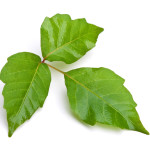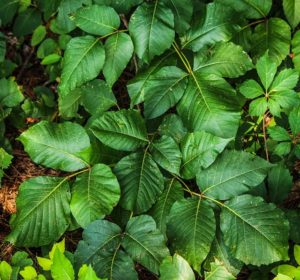
Do you know what causes poison ivy rash? It’s the sap oil that’s made by the poison ivy plant that’s responsible for irritant reactions, called “urushiol”. It’s the same substance that’s found in poison oak and poison sumac plants. If you’ve had a skin rash after coming in contact with one or more of these plants, you may already know that it’s uncomfortable, but not everyone is sensitive to these plants.
What is poison ivy?
Poison ivy is a plant that can cause inflammation of the skin known as “contact dermatitis.” Besides being the name of a plant, when people get the rash, they say “I have poison ivy.” The plant is found around the world, but it usually doesn’t grow in the desert or in high elevations. It usually grows in clusters in the woods, up in trees, and on the ground. Every part of the poison ivy plant; stem, leaves, root, fruit, and sap can cause an allergic reaction or contact dermatitis if a person comes in contact with it.
What does poison ivy look like?
Have you ever heard the rhyme, “Leaves of three, let them be?” Poison ivy plants are usually green with one stem and three leaves, but the leaves can also be red or brown or green with black dots depending on the weather and season.
![Image © [http://www.inmygarden.org/ Sue Sweeney] Poison_ivy_in_privet_hedge](https://youngmenshealthsite.org/wp-content/uploads/2015/05/Poison_ivy_in_privet_hedge-300x209.jpg)

Who is at risk for poison ivy?
Anyone of any race or ethnicity can get poison ivy. People who spend a lot of time outdoors doing activities such as mowing lawns or gardening/landscaping are at a higher risk.
What causes an allergic reaction to poison ivy?
Most people (85%) who come in contact with it will have an allergic reaction, but it’s actually the oil from the plant called, “urushiol” that’s responsible for the rash and other symptoms. Only fifteen percent of people will NOT have an allergic reaction when they come in contact with poison ivy.
People are at risk for getting poison ivy if they:
- Directly touch a poison ivy plant
- Touch something with “urushiol” on it – for example: petting an animal that has urushiol on its coat, or coming in contact with clothing that has urushiol on it.
- Breathe in smoke fumes from burning brush (containing poison ivy). This can cause a severe allergic reaction.
How can I tell if I’m allergic to poison ivy?
Signs & Symptoms:
- Redness and swelling of skin can sometimes occur after coming in contact with urushiol.
- Rash– A raised red rash can appear within hours (or even weeks) after coming in contact with urushiol.
- Bumps and itchy blisters appear soon afterwards. Eventually the blisters open and may ooze a clear liquid. The blisters then dry up and get crusty before the rash goes away. Touching the liquid or blisters will not cause the rash to spread.
Is poison ivy contagious?
You can get poison ivy if you come in direct contact with someone else’s skin that still has urushiol on it. However, you can’t get poison ivy by touching someone’s rash, blisters, or liquid from the blisters.
What should I do if I think I have poison ivy?
If you think you’ve come in contact with poison ivy, it’s important to avoid touching your eyes. Wash your skin with a special over-the-counter poison plant wash or use a degreasing soap or detergent. Lather up then rinse well with lots of water.
Once you have the rash:
Treatment: There’s no cure for poison ivy, but there are treatments to help you feel better until the symptoms go away (usually 1-3 weeks).
Try the following:
- Don’t scratch; it will only make the symptoms worse
- Take cool showers or lukewarm oatmeal baths
- Apply a cold wet cloth on the rash to help the itching
- Gently apply soothing lotion (ex. Calamine) on affected skin
Certain over-the-counter products will irritate the rash. Do NOT use certain ointments such as antihistamine creams or lotions that contain “benzocaine” (numbing medicine). Also, avoid products that contain neomycin or bacitracin, which are antibiotic ointments.
When should I call my health care provider (HCP)?
It’s important to call your HCP if you have a severe rash, especially if the rash is around your eyes, genitals, or most of your body, if you have a lot of swelling, if any of the blisters look infected (draining pus), or your rash doesn’t go away within 2-3 weeks. If you’re not sure if the rash is poison ivy, make an appointment to get checked.
Can I prevent poison ivy?
Yes! To help prevent poison ivy:
- Find out what the poison ivy plant looks like so you can try to avoid it. Remember, you can still get poison ivy from a dead plant.
- Don’t touch pets that have spent time outdoors near poison ivy.
- Wear long sleeve shirts and long pants when you spend time in areas that may have poison ivy.
- Take a shower right after you’ve come in contact with poison ivy (or you think you may have come in contact with it). Use soap but don’t scrub your skin.
- Hose your pet down with water if you think he/she has been in contact with poison ivy in order to remove the “urushiol” from its coat.
- Use vinyl gloves instead of latex or rubber gloves if you are doing yard work.
 Young Men's Health
Young Men's Health
